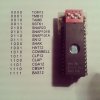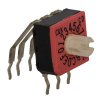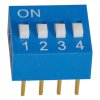I just came across this rather interesting photo in a forum dedicated to an 80's EPROM based digital drum machine:

Alas, there's not a whole lot of information available ther than this:
Since I have another EPROM based drum machine (Oberheim DMX) containing voice cards with either 2732 (4K) or 2764 (8K) EPROMs and I sometimes swap these with other EPROMs (for other sounds) I was wondering....
Could an adapter board similar to the above be made, which plugs into the EPROM socket and contains a large EPROM of some sort which, by the help of DIP switches allow the voice card to see multiple 2732 or 2764 EPROMs? That would save me from swapping EPROMs all the time (a ZIF socket helps, but this would also eliminate having all those EPROMs around).

Alas, there's not a whole lot of information available ther than this:
Anyone knows how many Chips uses the hihat sound on the LM1 ??? in my Linndrum are 4 2732
im tryin to get the LM1 sounds on my Linn but also using this new chip that a friend built to me , whiz is 16x a 2732.
just downloaded a file with the supposed LM1 sounds in bin format from here but there is only one bin file for the hihat also congas and toms , so I'm a little confused
here is a picture of the chip my friend built for me , with 16 switchable sounds
preety clever. but I'm figuring out how to get the longer sound without modify my linn, i thick i got it tho, but thats why i need to know how many chips are for the Hi Hat sound
Since I have another EPROM based drum machine (Oberheim DMX) containing voice cards with either 2732 (4K) or 2764 (8K) EPROMs and I sometimes swap these with other EPROMs (for other sounds) I was wondering....
Could an adapter board similar to the above be made, which plugs into the EPROM socket and contains a large EPROM of some sort which, by the help of DIP switches allow the voice card to see multiple 2732 or 2764 EPROMs? That would save me from swapping EPROMs all the time (a ZIF socket helps, but this would also eliminate having all those EPROMs around).









